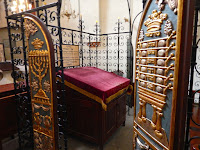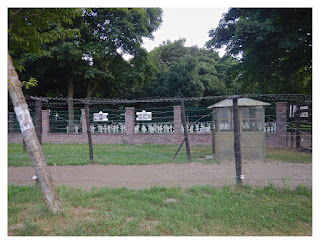Kazimierz
July 5 2019. Going through Poland we went to the second city of the country, Krakow. Like in Prague the Jewish quarter is quite impressive and their presence is a showroom of diversity. The Kazimierz district south of the Old Town was the centre of Jewish life in the city. From the XVI century to the Second World War it reunited a quarter of Krakow's 65'000 Jews.
 Since the heart enjoy legends here's the one for Krakow: in February 1335, two years after his coronation, king Kazimiers III gives the urban privilege to jews for their settling in the new city named after himself, Civitas Kazimiriensis. The romance had started when the king fell madly in love with the beautiful Jewish Esterka. It was then the first and biggest city founded by the king Kazimierz.
Since the heart enjoy legends here's the one for Krakow: in February 1335, two years after his coronation, king Kazimiers III gives the urban privilege to jews for their settling in the new city named after himself, Civitas Kazimiriensis. The romance had started when the king fell madly in love with the beautiful Jewish Esterka. It was then the first and biggest city founded by the king Kazimierz. After that, many wonders and great stories were built by the jewish community although passing through tribulations. The biggest one would arrive through the hands of the madness of nazi ideology. But before that, in the communist era it became one of Krakow's dodgiest districts while gradually falling into disrepair.
After that, many wonders and great stories were built by the jewish community although passing through tribulations. The biggest one would arrive through the hands of the madness of nazi ideology. But before that, in the communist era it became one of Krakow's dodgiest districts while gradually falling into disrepair.  Rediscovered in the 1990s, thanks to the fall of the regime and worldwide exposure through the lens of Steven Spielberg, Kazimierz has rebounded and is today krakow's most exciting district. A touristic site states "in fact, no other place conveys a sense of pre-war Jewish culture better than Kazimierz.
Rediscovered in the 1990s, thanks to the fall of the regime and worldwide exposure through the lens of Steven Spielberg, Kazimierz has rebounded and is today krakow's most exciting district. A touristic site states "in fact, no other place conveys a sense of pre-war Jewish culture better than Kazimierz.
Swastika nightmare
 The nazis begin Europe's nightmare upon their neighbor Poland on September 1939. From there onwards their Blitzkrieg was galvanized to pursue the 1000 years Reich.
The nazis begin Europe's nightmare upon their neighbor Poland on September 1939. From there onwards their Blitzkrieg was galvanized to pursue the 1000 years Reich.
When the German army entered Krakow they brought military intelligence agents to the city and one of such agents is Oskar Schindler.
The nazis took around 400 thousand soldiers of the Wojsko Polskie prisoners. Despite the defeat the Polish did not capitulate and continue facing the Nazis on the countryside.
 The nazi Hans Frank was Poland's general governor and he was really motivated to put the good people of Poland to work. Only a few weeks after the occupation it sets up a decree ordering poles between 14 and 60 years old to work, then he gradually extends to 10 hours of labour a day.
The nazi Hans Frank was Poland's general governor and he was really motivated to put the good people of Poland to work. Only a few weeks after the occupation it sets up a decree ordering poles between 14 and 60 years old to work, then he gradually extends to 10 hours of labour a day.
 The nazi Hans Frank was Poland's general governor and he was really motivated to put the good people of Poland to work. Only a few weeks after the occupation it sets up a decree ordering poles between 14 and 60 years old to work, then he gradually extends to 10 hours of labour a day.
The nazi Hans Frank was Poland's general governor and he was really motivated to put the good people of Poland to work. Only a few weeks after the occupation it sets up a decree ordering poles between 14 and 60 years old to work, then he gradually extends to 10 hours of labour a day. For me its impressive to see that this new philosophy to see human beings as work force have been planned before the war and it was not only meant for jews but for everyone. The Arbeitskarte (work card) was set to control everyone's work situation and it became a document even more important than the Kennkarte (German ID that was applied during the occupation) since it could protect its holder from forced deportation to work in the Reich.
For me its impressive to see that this new philosophy to see human beings as work force have been planned before the war and it was not only meant for jews but for everyone. The Arbeitskarte (work card) was set to control everyone's work situation and it became a document even more important than the Kennkarte (German ID that was applied during the occupation) since it could protect its holder from forced deportation to work in the Reich.Today Schindler brings a new sensation to Krakow and the "Fabrika Schindlera" became an essential place given a global view not only of Schindler's actions but of the war and of the jewish polish culture.
He who saves one life saves the world
Talmud

One surviver gives this wonderful testimony:
"And how many worlds did Oskar Schindler save? If it weren't for him, there would not be me, and there wouldn't be my family either, nor our descendants - my daughter and my two grandchildren, my brother Rysio's two sons, my cousin Olek's children, (...) the children and grandchildren of the others saved by Scindler. (...) So how many he really save then, when he saved 1,200 people? They are countless...
Useful sites
Schindler's Factory - https://www.muzeumkrakowa.pl/exhibitions/krakow-under-nazi-occupation-1939-1945
Synagogue Remuh à Cracovie - https://www.cracovie.fr/synagogue-remuhSchindler's Factory - https://www.muzeumkrakowa.pl/exhibitions/krakow-under-nazi-occupation-1939-1945
Log book: July 5th 2019 - 144 Kms * Pays: PL
Coordonnées
Old Jewish quarter of Kazimierz - 50° 3'3.11"N 19°56'59.22"E
Synagogue Remuh à Cracovie - 50° 3'9.61"N 19°56'50.41"E
Jewish Square - 50° 3'7.63"N 19°56'53.68"E
Deutsche Emailwarenfabrik (Oskar Schindler's Enamel Factory) - 50° 2'50.64"N 19°57'42.29"E



























































